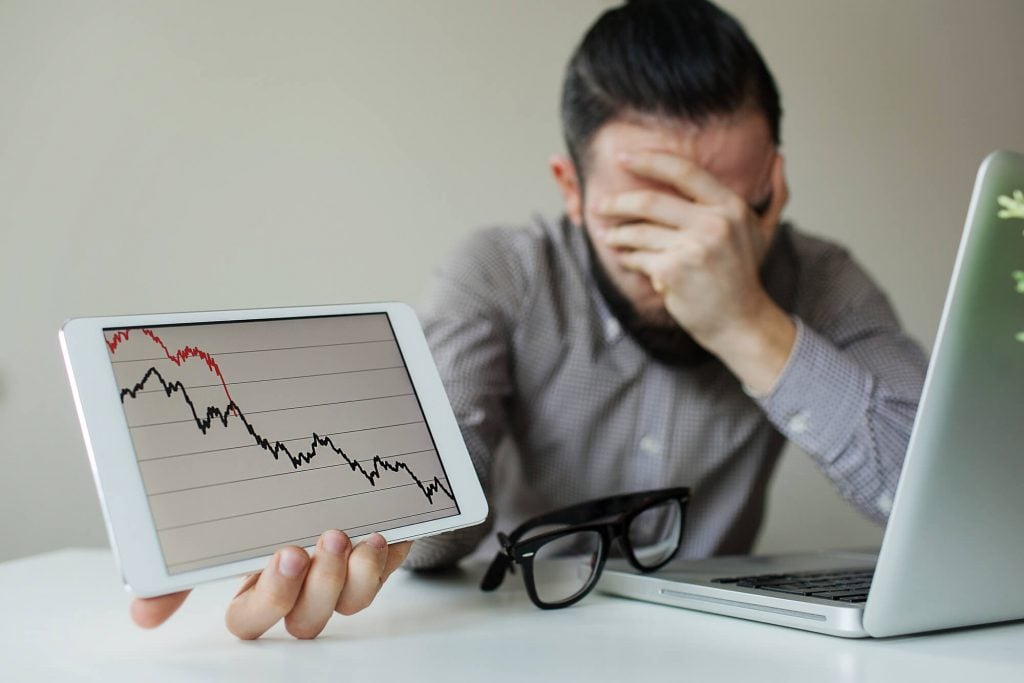Thousands of companies comprise the global stock exchange. With so many businesses fighting for investors and trying to turn a profit, it’s a little surprising that relatively few of them bottom out and lose all their value.
Can a stock go to zero? Yes, it can. And when investors see their stocks heading south, they may worry about their investments. What happens when a stock goes to zero — and if you’re a shareholder, what happens to you?

What Makes a Stock Go to Zero?
The foundation of the free market economy is supply and demand. A business thrives when it manufactures something that people want, and those people buy it. If the business continues to do that successfully, it grows and becomes more valuable.
The stock market works the same way. If enough investors buy into a certain commodity, its share price goes up and the company gains in market value. The goal of every company (good ones, anyway) is to sustain that demand for the long term and turn into a dependable, profit-making enterprise for their shareholders.
Conversely, when there’s no demand for a stock, shareholders unload their positions, and the price goes down. Some companies recover from such downturns, and some don’t.
What makes investors stay away from certain commodities? Several factors come into play, but the most significant one is earnings. If a company isn’t turning a profit on the goods or services it provides, investors take that as a warning sign. If they post losses for enough consecutive quarters, chances are they’ll lose a lot of their shareholders.
Other factors can influence the movement of the share price. Speculation in growth companies can drive market value higher, even if the company’s relatively new and hasn’t posted any profits yet. That can be dangerous, as investors found out in the dot-com bubble burst of 2000. Many companies once thought to be promising were perceived as overvalued, and many investors started selling off their shares. Most of those young dot-com companies never recovered, and those still hanging onto their shares to the bitter end lost all their value.
That’s the other big source of stock market valuation: investor sentiment. In turn, anything can influence that: industry news, leadership shakeups, corporate litigation, or some kind of scandal. Fairly or otherwise, outside events can motivate investors to make changes to their holdings in waves.
The only thing that’s certain in the stock market is — you probably saw this coming from a mile away — nothing is certain. Volatility is a constant on Wall Street. And sometimes stockholders pay a big price.
What Happens to the Company When Their Stock Goes to Zero?
Most big corporations are fairly immune to standard stock market fluctuations. It doesn’t really matter to Amazon if their stock price drops $100 in one day. For one thing, they’re currently worth over $3,200 a share. For another, they’re earning over $600 million a day. They’re a stable business that dominates the market and will be around until the end of time, which is as yet unscheduled.
Smaller, growth stocks, on the other hand, face dire circumstances when their stock drops that much. They rely heavily on outside investors to stay in operations. If their stock price is falling, that means those investors are fleeing — and other investors are noticing, staying away from any notion of buying in.
Declining stock prices may make it hard to keep employees around. This is especially true if stock options are part of their compensation package. Executives don’t like to see share prices drop either. Their fate is in the hands of shareholders, and if they see their portfolios drop in value, they may make moves to replace the CEOs they deem responsible.
Before a company hits rock bottom, they have to rectify the issues that are causing the losses — or face disappearing from the stock exchanges. The New York Stock Exchange (NYSE) and Nasdaq have a policy that if a public company’s share value remains below $1 for 30 consecutive business days, that company is put on notice. They have 6 months to get the price back over a dollar. If they fail to do so, they’re delisted from the stock exchange.
Many companies at least temporarily resolve this situation by declaring a reverse stock split. In this move, shareholders lose a certain number of shares, but the value of each share goes up. For example, in a 1:3 stock split, a shareholder who had 30 shares in a company at $1 sees their number of shares dwindle to 10 — but the value of each share increases to $3.
Some companies simply switch to other, smaller exchanges. They may decide to go over-the-counter (OTC), trading on “unofficial” broker-dealer networks with no minimum requirements for stock listing.
What happens when a stock hits 0? Most likely, they just stop being publicly traded and convert back to a private company. They may file for bankruptcy, though they don’t have to. But if they wish to continue doing business, they need to find new investors.
Sometimes, speculators will offer to invest in the company at almost pathetically low prices — say, a fraction of one penny per share. The hope here is that the company will resuscitate itself and get back to profitability. Then they’ll be rewarded if the company returns to offering common shares.
Believe it or not, it can happen. A company called GT Advanced Technologies filed for bankruptcy, and their share price remained stagnant at exactly 2 cents for years. They eventually got financing to exit Chapter 11, resurfaced as a public company, and got back on the exchange in December 2019. They’re currently trading around $25 a share. However, this is a very rare exception.

What Happens to Shareholders When a Stock Hits Zero?
So, let’s say the public startup you invested in a few months or years ago goes belly-up and loses all its value. Its stock price hits zero. What happens to you?
Well, it’s certainly not pleasant if you hold a long position. But the answer is simple: You lose the amount of your investment. Whatever value your stock had on paper is gone.
That’s about it. You’re pretty much done with this company, and you move on.
Investors who are new to the game sometimes worry about their responsibilities in case a stock they own crashes. Can the stock actually go below zero? If it does, would you owe someone money, since you earned it when share prices went up?
The answer is simple here, too: No. A stock price can never actually go below zero. So you won’t owe anybody any money. You just won’t have anything.
If a company goes out of business, they’ll likely have outstanding debts that creditors will try to collect. However, even though your shares represent ownership in the company, these creditors will not be going after you. US legislators have instituted laws that prevent public shareholders from any financial responsibility if the companies they invest in fail. Creditors can only go after the corporation.
So you’re good. Well, not good, but off the hook.
How to Avoid Heavy Losses When a Stock Goes to Zero
A stock hitting zero value is an extremely rare event. Chances are, if you have a nicely diversified portfolio and have a healthy number of bedrock, dependable stocks, you really don’t have too much to fear in that department.
But a stock losing all of its value does, occasionally, happen, especially with small companies and high-rise startups. Here are a few tips for staving off the damage to your portfolio.
Set Stop-Loss Limit Orders
Stop-loss orders do exactly what their name implies: They stop you from losing more money on a failing stock after their price drops to a specified level. You can set limits at whatever point you feel comfortable losing. Some investors set limits for losses of 15% or 20% of their original purchase price. Others, especially day traders, shoot for extremely narrow losses of 1% to 3%. But any percentage you feel okay about works fine.
Stay On Top of Your Portfolio
Keep tabs on all the positions that you hold. Most of the major online brokerages offer analysis and charts that can help you see what direction your stocks have been going. Get to know a few statistical tools — such as moving averages — that can give you a better picture of where your holdings are headed.
Get to Know Your Investments
Understand what every company you invest in actually does. What products or services do they offer? How are they positioned in their business sector? What are their prospects for the near and distant future? What recent events could impact their standing? Be proactive about seeking information on every one of your holdings — and don’t be reluctant to make decisions if the future doesn’t look good.

Gorilla Trades: Keeping Your Head Above Water
Gorilla Trades helps our customers do more than stay afloat in times of economic uncertainty. We don’t just provide data-centric stock picks — we identify the precise points to enter and exit positions to reap maximum profits. Sign up for a free trial to find out more.




